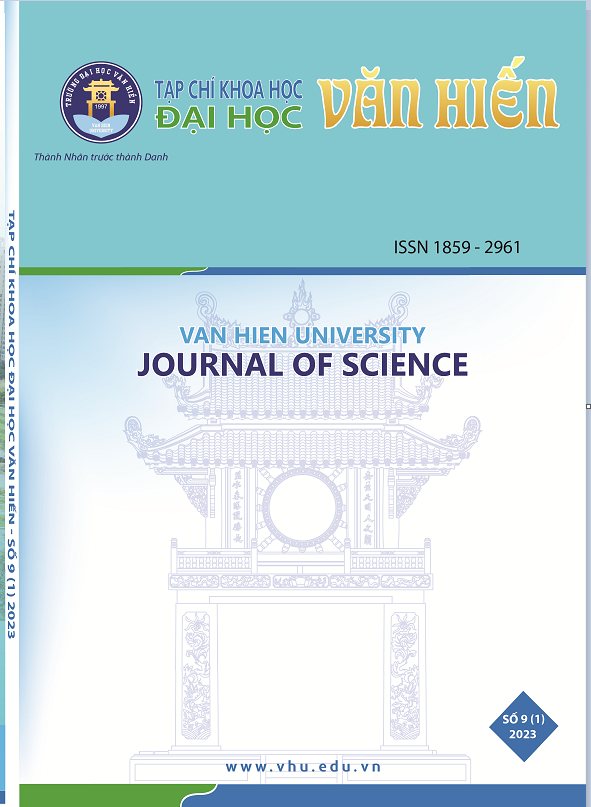Exploring the green food consumption intention of the people in Ho Chi Minh City
Main Article Content
Abstract
Article Details
References
Aertsens, J., Mondelaers, K., Verbeke, W., Buysse, J., and Van Huylenbroeck, G. (2011). The influence of subjective and objective knowledge on attitude, motivations and consumption of organic food. British food journal, 113(11): 1353-1378. https://doi.org/10.1108/00070701111179988
Ajzen, I. (1991). The theory of planned behavior. Organizational Behavior and Human Decision Processes, 50(2): 179-211. https://doi.org/10.1016/0749-5978(91)90020-T
Albayrak, T., Aksoy, Ş., and Caber, M. (2013). The effect of environmental concern and scepticism on green purchase behaviour. Marketing Intelligence and Planning, 31(1): 27-39. https://doi.org/10.1108/02634501311292902
Atkinson, L., and Rosenthal, S. (2014). Signaling the green sell: The influence of eco-label source, argument specificity, and product involvement on consumer trust. Journal of Advertising, 43(1): 33-45. https://doi.org/10.1080/ 00913367.2013.834803
Chen, T.B., and Chai, L.T. (2010). Attitude towards the environment and green products: Consumers’ perspective. Management Science and Engineering, 4(2): 27-39. http://dx.doi.org/10.3968/j.mse.1913035X20100402.002
Fuchs, V.R. (1972). Health care and the United States economic system: an essay in abnormal physiology. The Milbank Memorial Fund Quarterly, 50(2): 211-237. https://doi.org/10.2307/3349445
García-Fernández, J., Fernández-Gavira, J., Sánchez-Oliver, A.J., Gálvez-Ruíz, P., Grimaldi-Puyana, M., and Cepeda-Carrión, G. (2020). Importance-performance matrix analysis (IPMA) to evaluate servicescape fitness consumer by gender and age. International Journal of Environmental Research and Public Health, 17(18): 6562. https://doi.org/10.3390/ijerph17186562
Geiger, S.M., Fischer, D., and Schrader, U. (2018). Measuring what matters in sustainable consumption: An integrative framework for the selection of relevant behaviors. Sustainable development, 26(1): 18-33. https://doi.org/10.1002/sd.1688
Ghodeswar, B., and Kumar, P. (2014). A study of green marketing practices in Indian companies. International Journal of Applied Management Sciences and Engineering (IJAMSE), 1(2): 46-64. http://doi.org/10.4018/ijamse.2014070104
Gyurcsik, N.C., Brawley, L.R. (2000). Mindful Deliberation About Exercise: Influence of Acute Positive and Negative Thinking. Journal of Applied Social Psychology, 30(12): 2513-2533. https://doi.org/10.1111/j.1559-1816.2000.tb02448.x
Hair, J.F., Ringle, C.M., and Sarstedt, M. (2011). PLS-SEM: Indeed a silver bullet. Journal of Marketing theory and Practice, 19(2): 139-151. https://doi.org/10.2753/MTP1069-6679190202
Kashif, M., and De Run, E.C. (2015). Money donations intentions among Muslim donors: an extended theory of planned behavior model. International Journal of Nonprofit and Voluntary Sector Marketing, 20(1): 84-96. https://doi.org/10.1002/nvsm.1519
Kumar, P., and Ghodeswar, B. M. (2015). Factors affecting consumers’ green product purchase decisions. Marketing Intelligence and Planning, 33(3): 330-347. https://doi.org/10.1108/MIP032014-0068
Lee, K. (2009). Gender differences in Hong Kong adolescent consumers' green purchasing behavior. Journal of consumer marketing, 26(2): 87-96. https://doi.org/10.1108/07363760910940456
Liên Hợp Quốc Việt Nam (2015). Các Mục tiêu Phát triển Bền vững tại Việt Nam. https://vietnam.un.org/vi/sdgs
Lockie, S., Lyons, K., Lawrence, G., and Mummery, K. (2002). Eating ‘green’: motivations behind organic food consumption in Australia. Sociologia ruralis, 42(1): 23-40. https://doi.org/10.1111/1467-9523.00200
Martilla, J.A., and James, J.C. (1977). Importance-performance analysis. Journal of marketing, 41(1): 77-79.
Martineau, P. (1958). Social glasses and spending behavior. Journal of Marketing, 23(2): 121-130. https://doi.org/10.1177/002224295802300201
Maslow, A.H. (1981). Motivation and personality. New Delhi, Prabhat Prakashan.
Ngô Thị Duyên và Phạm Thị Ngoan (2019). Thúc đẩy tiêu dùng xanh của các hộ gia đình Việt Nam hiện nay. Tạp chí tài chính. https://tapchitaichinh.vn/nghien-cuu-trao-doi/thuc-day-tieu-dung-xanh-cua-cac-ho-gia-dinh-viet-nam-hien-nay-302162.html
Paul, J., Modi, A., and Patel, J. (2016). Predicting green product consumption using theory of planned behavior and reasoned action. Journal of retailing and consumer services, 29: 123-134. https://doi.org/10.1016/j.jretconser.2015.11.006
Peña-García, N., Gil-Saura, I., Rodríguez-Orejuela, A., and Siqueira-Junior, J.R. (2020). Purchase intention and purchase behavior online: A cross-cultural approach. Heliyon, 6(6): e04284. https://doi.org/10.1016/j.heliyon.2020.e04284
Rahbar, E., and Wahid, N. A. (2011). Investigation of green marketing tools’ effect on consumers’ purchase behavior. Business strategy series, 12(2): 73-83. https://doi.org/10.1108/17515631111114877
Ringle, C.M., and Sarstedt, M. (2016). Gain more insight from your PLS-SEM results: The importance-performance map analysis. Industrial management and data systems, 116(9): 1865-1886. https://doi.org/10.1108/IMDS-10-2015-0449
Straughan, R.D., and Roberts, J.A. (1999). Environmental segmentation alternatives: a look at green consumer behavior in the new millennium. Journal of consumer marketing, 16(6): 558-575. https://doi.org/10.1108/07363769910297506
Tanner, C., and Kast, S.W (2003). Promoting sustainable consumption: Determinants of green purchases by Swiss consumers. Psychology and marketing, 20(10): 883-902. https://doi.org/10.1002/mar.10101
Thủ tướng Chính phủ (2021). Quyết định: Phê duyệt chiến lược quốc gia về tăng trưởng xanh giai đoạn 2021 - 2030, tầm nhìn năm 2050.
UN DESA (2015). Transforming our world: The 2030 agenda for sustainable development. United Nations, Department of Economic and Social Affair, A/RES/70/1.
Wu, P.C.S, Yeh, G.Y-. Y., and Hsiao, C-. R. (2011). The effect of store image and service quality on brand image and purchase intention for private label brands. Australasian Marketing Journal (AMJ), 19(1): 30-39. https://doi.org/10.1016/j.ausmj.2010.11.001
Young, W., Hwang, K., McDonald, S., and Oates, C.J. (2010). Sustainable consumption: green consumer behaviour when purchasing products. Sustainable development, 18(1): 20-31. https://doi.org/10.1002/sd.394



